Ethiopia and Back and The Wrap

Karen with two customers in an Ethiopian brew pub just outside Addis Ababa. One sip was enough:)
I’m writing this from a hotel room in Southampton, UK, awaiting a taxi to Heathrow and the flight(s) home after 46 days on the road. How do I wrap this trip up? As with most of our trips, this has been a trip of extremes, but in some ways it feels extremely extreme:) We’ve been in the lap of luxury and in the very definition of poverty. We’ve laid around and did almost nothing and dragged our bags/bike/whatever across more airports, ferry stations, bus stations, and city-scapes than I can remember. We’ve been in mountains, desert, seaside, countryside, modern and ancient cities. On planes, ferries, buses, cars, taxis, and a motorcycle — more than once each time. We’ve gotten drunk on a beach and had a lunch hosted in our honor at the U.S. Ambassador’s residence in Addis Ababa, Ethiopia (the capital of Ethiopia). We’ve been hot, cold, dry and wet, often in the same day. We never knew the language of the country we were in, but somehow found ways to connect with the people there.
Maybe the best way is to go to the stats:
Trip Stats & Awards
- Countries: UK, Spain, Morocco, Ethiopia
- Cities visited: best guess is 21
- Miles on a motorcycle: 2975
- Overall miles: My guess is 20,000
- Plane legs: 11 including prop planes landing on unpaved runways
- Ferries: 4
- Speeches made in Ethiopia: 24
- Press interviews: 4
- Ethiopian Officials met with: Mayor of Addis, Minister of Water, Irrigation & Electricity, State Ministers of Industry, Science & Technology, Small & Medium Business, Investment and Urban Development
- Least Friendly Awardee: Any airport employee at Charles DeGualle airport with a special shout out to Air France employees
- Most Accommodating New Friends: Maureen and Miguel in Madrid who single-highhandedly made our trip to/from Madrid and Ethiopia painless and quite enjoyable
- Best Beach Town and Beach: Tarifa and Bolonia, both on the tip of Spain
- Number of Motorcycle Problems: 0:))
The Beaches of Southern Spain
After five days in Morocco, getting back to the “civilization” of Southern Spain was needed. A couple of weeks earlier a bartender in Granada had told us to go to a little-known beach named Bolonia on the southern coast. He assured us it was worth it, but it wasn’t on any map or in the GPS. As luck would have it, we found Bolonia and it IS one of the best beaches we’ve ever been on. It was so great, we spent three nights there just hang’n at the beach and prepping for Ethiopia. We met some folks there from the UK and had a great time partying Spanish style. It’s one of those places I could of hung for much longer, but we needed to get to Madrid.
Getting to Madrid
After Morocco, we needed to weave our way towards Madrid to catch the plane to Addis Ababa (Ethiopia). We skipped Seville and spent some terrific nights in Cordoba and Toledo. Both towns were in the midst of festivals and such, so in the space of a couple of nights we went to a rock & roll concert, an equestrian show, a flamingo dance show, and a couple of tours of old churches thrown in. Each night was filled with something old and new.
Madrid
Before our trip, someone told us to skip Madrid as it was “just another big city”. Well, our time in Madrid was terrific, mainly because we met Maureen and Miguel there. Long story short, Maureen is a friend of Sam H.’s and she agreed to be our Logistics Command Center. We left the bike and all our m/c clothes and gear with her, which made the entire Ethiopia leg possible. More importantly, we had a couple of great nights out with them and thoroughly enjoyed the city. I was even getting use to eating dinner at 10PM! Madrid has a vibrant night life, which was a nice contrast to Morocco before and after Ethiopia. Both KR and I could live there.
Ethiopia
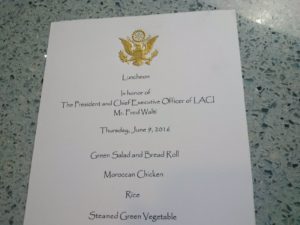 There is no way on earth that I can describe Ethiopia to you. This was our first trip to Africa (Morocco doesn’t count) and we didn’t know what to expect. My purpose in going was to give a lot of speeches and take a lot of meetings extolling the business opportunity that clean technologies represent for Ethiopia and Sub-Sahara Africa.
There is no way on earth that I can describe Ethiopia to you. This was our first trip to Africa (Morocco doesn’t count) and we didn’t know what to expect. My purpose in going was to give a lot of speeches and take a lot of meetings extolling the business opportunity that clean technologies represent for Ethiopia and Sub-Sahara Africa.
Development wise, Ethiopia makes India look like a fully developed paradise. There is little infrastructure, even in its capital City, Addis Ababa. Side walks? rare. Electricity? 10 million people have been on a waiting list to get electricity for ten years. Water? They’re in a much worse drought than California. Traffic? Yes and its made up of cars, buses, cows, people, m/c’s, bicycles and tuk tuks. With few traffic signals, no street signs and no addresses. Modern buildings? Well, yes and no. There are dozens and dozens of new building part way finished (in Ethiopia, you build the basic structure, put a bank on the first floor, and hope you generate enough profits from the bank to finish the building.) Yet none of them look new.
Aside from all of that, Ethiopia is a lovely country. The people, despite their relative poverty, are generally a happy/smiling lot. They are as honest as the day is long. They’re colorful and energetic. Addis is a dirty hub bub of a city, but there’s a lot of action. The young people that I spoke to, were bright, energetic, hopeful and determined to make things better. The government officials seemed genuinely interested in making things better for their citizens.
I was only able to experience a tiny bit of Addis as most of my days consisted of getting driven around to various meetings in an Embassy car. That’s literally how I saw Addis – through the windows of lots of Toyota Land Cruisers.
Over the weekend, Karen and I took a plane to northern Ethiopia to see the “real” Ethiopia, which is the cradle of civilization. The remains of the oldest human being was discovered in Ethiopia and dates back millions of years. We went to Lalibela, a village in northern Ethiopia that has 12 churches carved into granite mountains, each church from a single piece of stone. Took 14,000 people about 100+ years BC to build.
Ninety percent of the people outside the cities are subsistence farmers. They farm the way their ancestors did — by hand and with donkeys. Their key assets are goats and cows, live in grass/mud huts, with no running water. With a few exceptions, of course: cell phones and satellite dishes:)
It does beg the question: how did one of the oldest civilizations on earth not develop further and faster? What happened?
Damn if I know.
Both Karen and I would go back, and probably will because of business. Now that we’ve had our first taste of Africa, we’re curious about the rest. That’s for another day and time.
A Couple of Final Thoughts
- If you’re going to Spain, go in May before everyone gets there. It only rained about a week out of five and was otherwise beautiful.
- Maybe as a result of the above, Spain was incredibly cheap compared to the US, UK, France, Swiss, etc. It was easy to find a decent hotel for less than 100 Euros.
- Stay off the main Autopista’s and take the back roads. Once we did that, we saw a wonderful countryside of small villages, rolling hills, and a few mountains. The m/c riding is better that way, too.
- If you take the ferry from the UK to Spain or France, spend the extra bucks for a room or mini suite. It was lovely and a nice way of spending 24 hours.
- BMW 1200 GS’s rule! Long live Now Voyager II.
Here’s what everything looked like.
Take care, fred
SPAIN

One of the most welcome sights on this trip: KR bringing us drinks in Bolonia
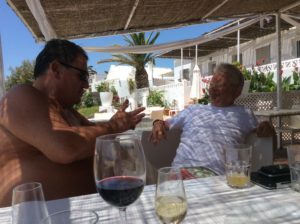
Tim and I are engaged in “lunch” Spanish style. That would be a couple bottles of wine, a couple of beers, two or three different kinds of pig, and a couple of tapas. Lunch goes from 12:30-4:30 in Bolonia. Then back to the room for a nap and ready to go by 7:)
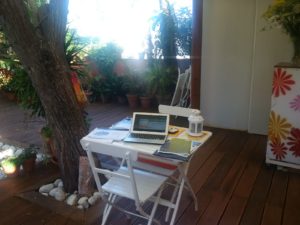
Bolonia was a great place to write the Ethiopian speeches
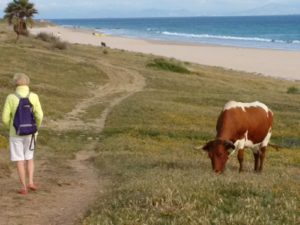
Cows and horse roamed the Balonia beach
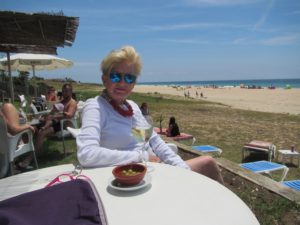
Happy camper
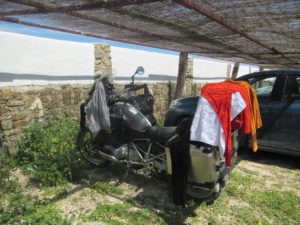
Versatile work horse: NV II as clothes line
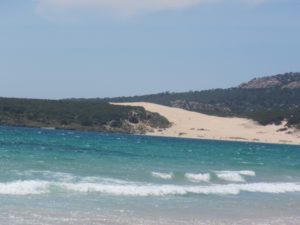
Bolonia beach

Rock concert in Toledo
![IMG_20160530_232146[1]](https://www.therestlesstraveler.com/wp-content/uploads/2016/06/IMG_20160530_2321461-300x225.jpg)
Maureen and Miguel in Madrid. And I was just getting use to eating at 10PM
ETHIOPIA – ADDIS ABABA

“Lecture” at Addis Ababa University

Meeting the “Girls can Code” group

Speaking to the AmCham Steering Committee
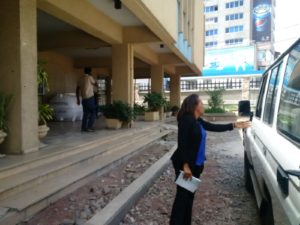
Getting out of the car at the Ethiopian Investment Ministry. Notice the “side walk”:)

The information booth at the “American Center.” No kidding:)
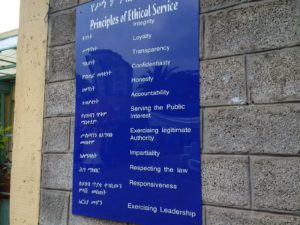
“Principles of Ethical Behavior” posted outside a minister’s office. While certainly needed in much of Africa, we could probably remind ourselves of these as well
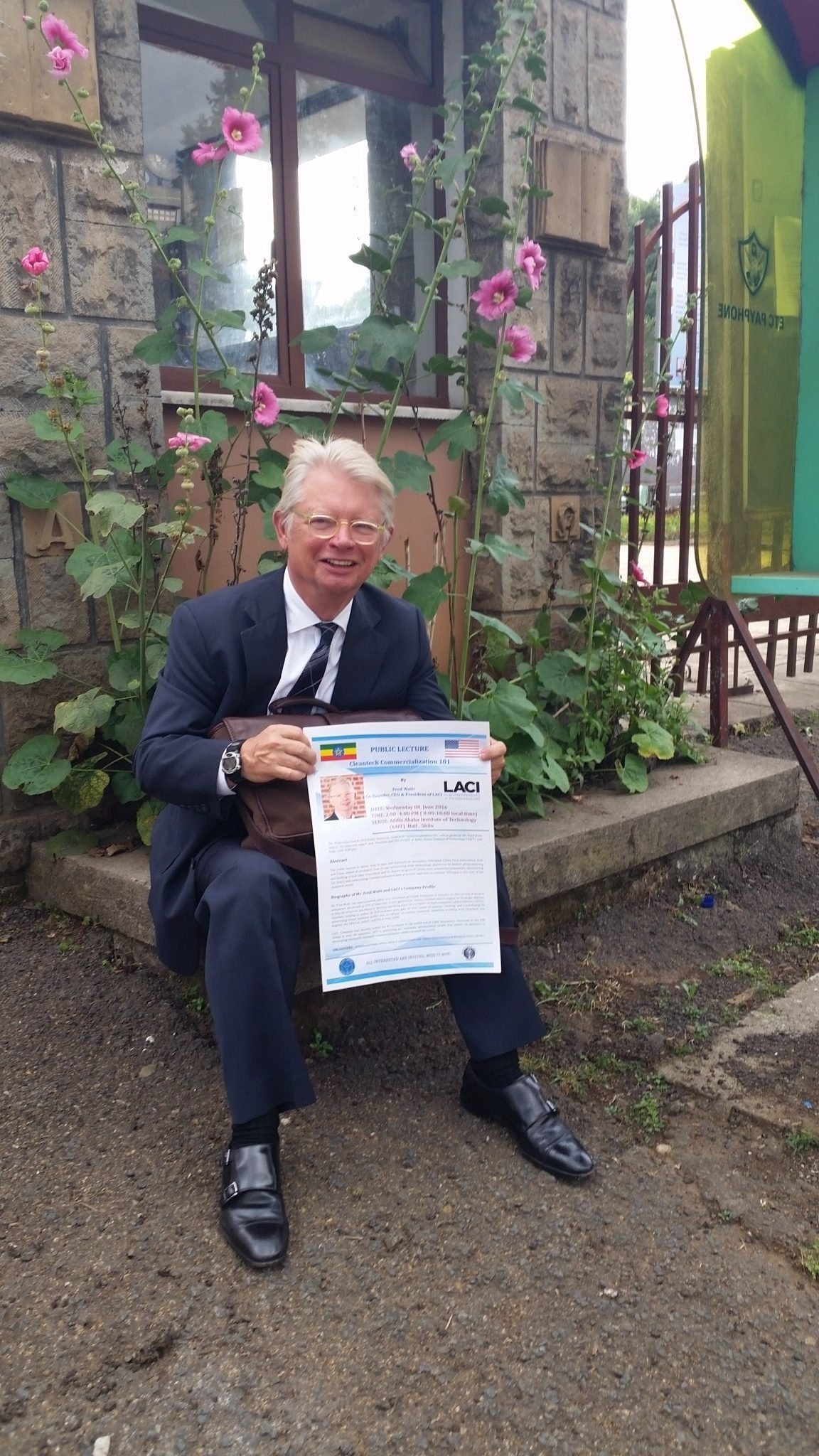

Tanya and Yemi, from the U.S. Embassy, took great care of us.

The Palace. We stayed at the Sheraton Palace, by far the most luxurious hotel in Ethiopia. The Sheraton’s lobby was the ad hoc meeting central for all International business meetings.
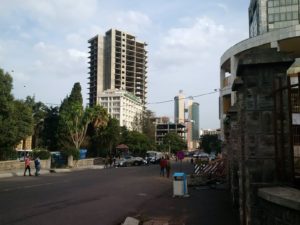
Addis street

The “shopping center” that the U.S. Embassy recommended Karen shop at.
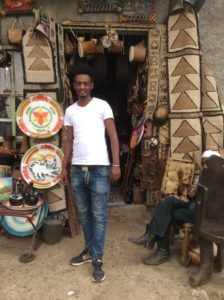
Shopkeeper. He’s probably smiling because KR bought something.
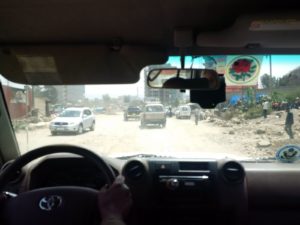
My normal view of Addis– through the windows of an Embassy car
THE “SUBURBS” OF ADDIS ABABA
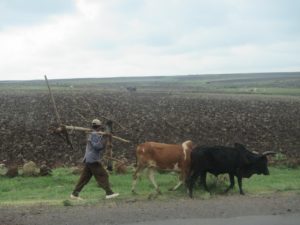
Karen got a chance to get outside Addis in the countryside
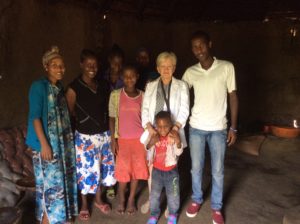
Karen insisted on meeting real people, so her tour guide knocked on a door of a random house. K.aren spent a couple hours with a woman and her 19 children

Their kitchen with the oven on the floor.

A bedroom

Mom making afternoon tea

Some of her children, who brought

home an English test they took that day.
THE FAR NORTH OF ETHIOPIA
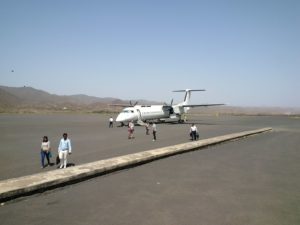
Two of my least favorite things: prop planes and gravel runways. We land way up north in Lalibela.
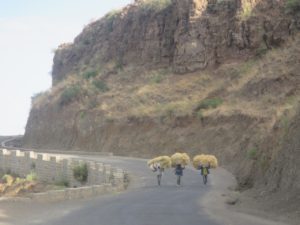
Three men carrying hay for their animals. When we caught up to them, they were easily a mile from town and almost race walking.
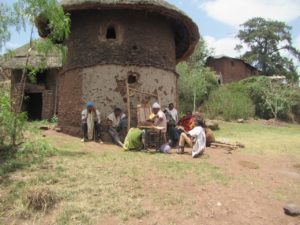
House in Lalibela
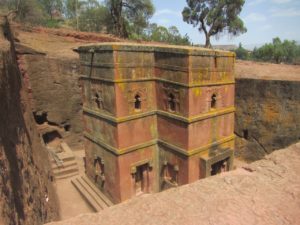
Lalibela is famous for 11 churches carved into the mountain, each from a singular piece of granite. Built between 1000 BC and 600AD when Ethiopia was a large Christian empire spanning the Horn of Africa and much of Arabia.
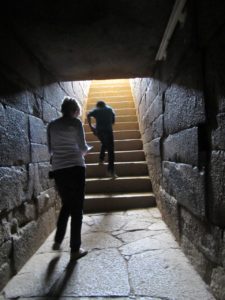
This is church #2, or is it 4….

A visitor praying in one of the churches
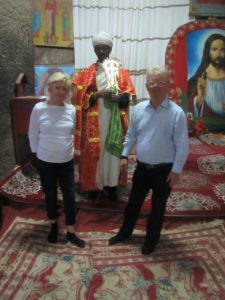
Each church as a resident priest. For a pennies, you can get a picture with the priest

Our guide took us to the Saturday market. We started walking down this path, which had a lot of traffic.

We rounded a corner and came upon this; hundreds of people and their animals in the market.

We of course waded right through the middle of the crowd. Unbelievable.
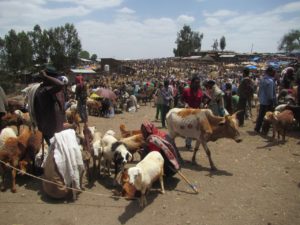
It was a very competitive marketplace with lots of people offering goats, cattle, donkeys and everything in between. Not knowing a good goat from a bad goat, I wonder how one picked one over the other:)
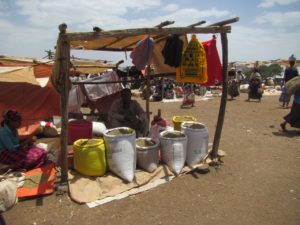
Spices
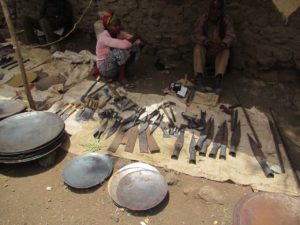
Tools, knives and plow heads

Stall after stall of grains, teas, spices, coffee, et al.

Back to the Sheraton, and a toast among the crew to a great trip.
THE FINAL LEG HOME

Back home on NVII on our way from Madrid to Santander on the northern coast. We had one more great day of riding.

We kept off the main roads and came across lots of villages like this
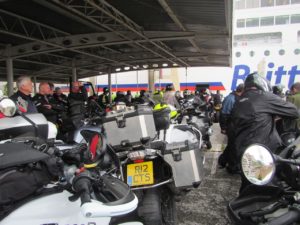
Awaiting loading on the ferry back to Portsmouth

One of my better decisions was to get a mini suite on the Mini Queen Mary. A great way of spending 24 hours.
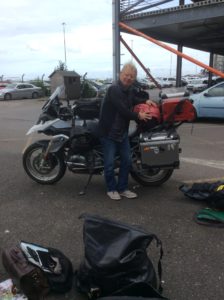
Back at Southampton and NVII is ready to be loaded on the ship back home. NV II is one great motorcycle.
Until the next time.


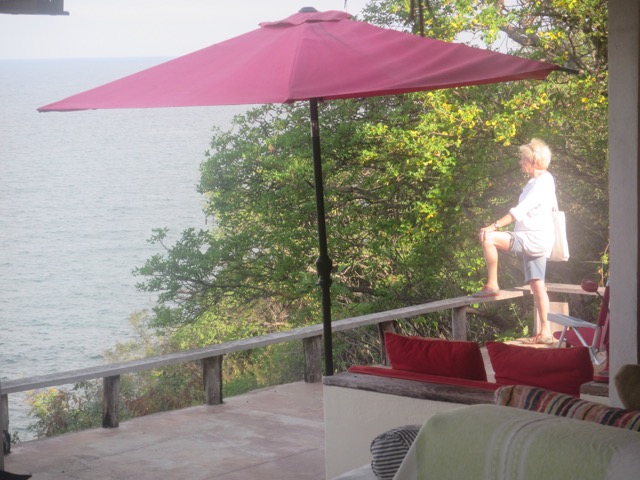

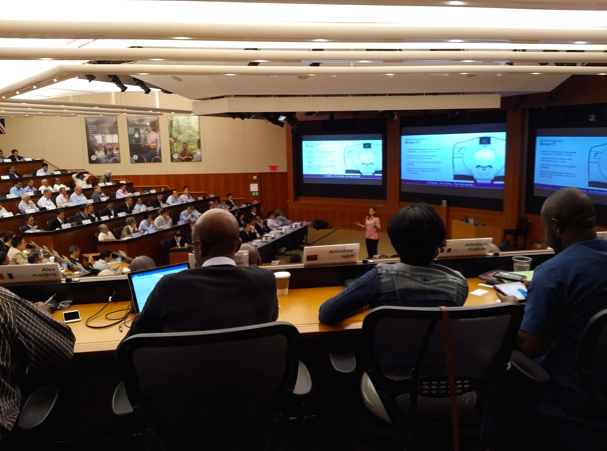


Fred and Karen, just read all four posts. What a great trip! And your writing, FW, always funny and vibrant, allowed me to go along for the ride. Glad you’re home, but even happier you had this trip together. Hugs, C
You guys are “world travelers” that you probably never knew you would be just a few years ago. Amazing trips you have captured with your pictures and stories. Thanks for sharing.
Fred and Karen, I love your trips and how beautiful you present where you are and what you’ve seen–One can only wish you well as
you figure out “what’s next”.